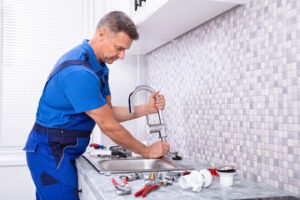The kitchen faucet is one of the most important appliances in your home. Like most appliances, however, it will eventually wear out and require repairs or replacement.

Faucet repairs can save you money and time in the long run. If the problem is simple, such as a leak or worn part, it may be worth it to try and fix it yourself before hiring a plumber to do the work for you.
Having a leaky faucet is frustrating, but it’s also an expensive problem that can lead to mold growth and other health problems. If you can’t afford to have a plumber fix your faucet, you can try some DIY kitchen faucet repairs to solve the problem.
First, make sure you’ve turned off the water supply to your home. This will prevent the dripping from ruining your counters, flooring, and furniture while you work on the repair.
Then, remove the decorative caps on each handle. You’ll need to use a flathead screwdriver to gently lift them up and expose the screws underneath. Set the parts aside in order as you take them off, so that they are organized when you reassemble your faucet.
Once you’ve removed the decorative caps, take the handles off of the stem. This can be difficult to do if the screw has become seized, so you may need to use penetrating oil to loosen the threads and break up any rust or sediment.
Next, you’ll need to remove the packing nut on the stream screw, which secures the handle to the faucet stem. This nut can loosen over time and cause your faucet to leak.
After you’ve removed the packing nut, inspect the O-ring that is responsible for keeping water out of your faucet handle. If it’s worn, replace the O-ring with a new one before you reassemble the handles.
The seat washer that sits atop the O-ring is another component that can wear out over time. This is typically a rubber part that keeps the O-ring from moving around when you’re using your faucet, so if it starts to show signs of wear, it’s a good idea to replace it before your faucet starts leaking.
Finally, once you’ve replaced the O-ring and seat washer, check to see if there are any signs of corrosion on your faucet handles. Mineral buildup is a common problem with older faucets and can cause them to leak.
If you notice any signs of corrosion on your faucet handles, or if they’re dripping, it’s a good idea to bring in a professional to replace them for you. You can get a free, no-commitment estimate from a licensed plumber near you to help you determine whether you’re dealing with a problem or just a simple repair job.
Leaky faucets are annoying and can lead to mold, water damage, and health problems. They also cost homeowners a lot of money on their water bills and may interfere with daily activities.
If you notice a leak, it’s important to call for help immediately. Dripping faucets can waste over 100 gallons of water per month, leading to high utility bills and potentially serious plumbing repairs.
Faucet parts wear out over time, so it’s important to replace them periodically. Some worn parts can be repaired easily, but others need to be replaced altogether.
Inspect all faucet parts for signs of wear, damage, or corrosion. If the parts have been damaged by rust, you might need to clean and refinish them. You can also sanitize them by soaking them in vinegar to loosen mineral deposits.
Take out the valve cartridge or stem, then inspect it for corroded or defective parts. Some cartridges are easy to remove and slide out of the handle, while others require you to loosen a nut with a pipe wrench.
Check the rubber O-rings for wear and tear, as well as the seat washer (the thicker rubber band at the bottom of the stem). If they’re both deteriorating, you’ll need to replace them, or else your faucet will keep leaking.